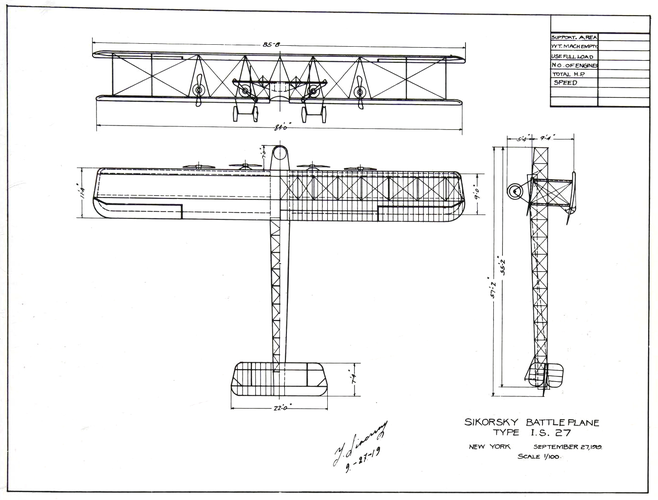- Joined
- 25 June 2009
- Messages
- 14,142
- Reaction score
- 4,334
After the 1917 Bolshevik Revolution in Russia declared Igor Sikorsky an "enemy of the working class" and slated him for execution, Igor Sikorsky understood that he was no longer safe, especially as some very good friends of his were executed without any form of trial. He escaped to Murmansk, where he embarked the English freighter Oporto. One week later he disembarked the ship in England, as a free man. In England Sikorsky tried to sell his plans, but nobody was interested in them, most likely because of the biases against the aviation in `backward' Russia. In France he had more success and obtained a contract with the French government to built a large bomber. The Avion Atlas, as it was called ("Atlas airplane"), was to be powered by two Liberty engines and capable to carry a one-ton bomb. Later the customer suggested the use of four Hispano-Suiza engines. Five aircraft were ordered but the situation changed rapidly and with the Armistice of November 1918, the French bomber was no longer needed. A week before the prototype went up in the air the French blew up the project.
On February 2, 1919, Igor Sikorsky left from London to the United States, where he, just like thousands of other refugees, would try to build a new existence. After arriving in New York, he tried to sell his aeroplane designs, but when this didn't work out he decided to start his own aeroplane factory. With Christoffer Hannevig he set up the Hannevig-Sikorsky Aircraft Corp. in Wantagh, on Long Island. Fellow Russian expatriates including Alexander Prokofiev de Seversky (of later Seversky/Republic fame) joined the company. In June 1919, they designed a heavy bomber with a payload capacity of up to 5 tons, presumably derived from the Avion Atlas design, for Aleksandr Vasiliyevich Kolchak's White Army, which tried to overthrow the Bolshevik revolution. For some unknown reason, this too remained a project.
Final evolution of the Atlas bomber was the Sikorsky Battleplane, or I.S.27. It was a big biplane with 4 tractor engines mounted low on the lower wing with a big wing gap. The design is dated September 27, 1919, with "New York" and the date "9-27-19" clearly hand written next to Igor Sikorsky's signature. That drawing appears on p.67 of The aviation careers of Igor Sikorsky. The book is said to heavily rely on archival material now held in the archive of United Technologies and can therefore be considered as authoritative.
The I.S.27 bomber drew sufficient interest from the U. S. Army Air Service, which offered Sikorsky the opportunity to submit a design for a bomber, designated as the UTC AS-2, whatever that meant.
Please note that previous reference to the Avion Atlas and the Kolchak army bomber projects as "S-28" is not consistent with the chronology, as both projects clearly predate the I.S.27 drawing and can therefore be considered as part of the same general "S-27" program. Next Sikorsky design, dated November 1919, and clearly identified as the S-28 in a drawing, was a multi-seater biplane passenger transport with a 40-meter span and three 700 hp engines.
Sources:
On February 2, 1919, Igor Sikorsky left from London to the United States, where he, just like thousands of other refugees, would try to build a new existence. After arriving in New York, he tried to sell his aeroplane designs, but when this didn't work out he decided to start his own aeroplane factory. With Christoffer Hannevig he set up the Hannevig-Sikorsky Aircraft Corp. in Wantagh, on Long Island. Fellow Russian expatriates including Alexander Prokofiev de Seversky (of later Seversky/Republic fame) joined the company. In June 1919, they designed a heavy bomber with a payload capacity of up to 5 tons, presumably derived from the Avion Atlas design, for Aleksandr Vasiliyevich Kolchak's White Army, which tried to overthrow the Bolshevik revolution. For some unknown reason, this too remained a project.
Final evolution of the Atlas bomber was the Sikorsky Battleplane, or I.S.27. It was a big biplane with 4 tractor engines mounted low on the lower wing with a big wing gap. The design is dated September 27, 1919, with "New York" and the date "9-27-19" clearly hand written next to Igor Sikorsky's signature. That drawing appears on p.67 of The aviation careers of Igor Sikorsky. The book is said to heavily rely on archival material now held in the archive of United Technologies and can therefore be considered as authoritative.
The I.S.27 bomber drew sufficient interest from the U. S. Army Air Service, which offered Sikorsky the opportunity to submit a design for a bomber, designated as the UTC AS-2, whatever that meant.
Please note that previous reference to the Avion Atlas and the Kolchak army bomber projects as "S-28" is not consistent with the chronology, as both projects clearly predate the I.S.27 drawing and can therefore be considered as part of the same general "S-27" program. Next Sikorsky design, dated November 1919, and clearly identified as the S-28 in a drawing, was a multi-seater biplane passenger transport with a 40-meter span and three 700 hp engines.
Sources:
- http://www.theaerodrome.com/forum/499998-post20.html
- Glasnost Gleams On Aviation Pioneer, in Ocala Star-Banner, 25 April 1990
- French aircraft of the First World War, p. 465
- The aviation careers of Igor Sikorsky, by Dorothy Cochrane von Hardesty and Russell Lee, p.62-67 (published by the NASM: ISBN 0-295-96916-4) *
- Sikorsky Wings, by G. Katyshev and V. Mikheev, 1992 *
- Unknown Sikorsky by V. Mikheev, 2010 *
- Sikorsky, by V. R. Mikheev and G. I. Katyshev, Polytekhnika Izdatelstvo, 2003.


